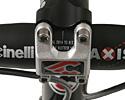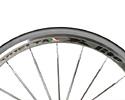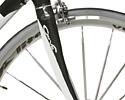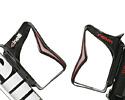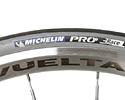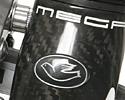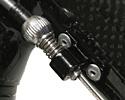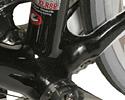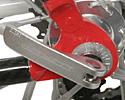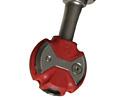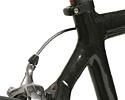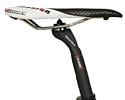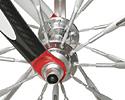
Recently on Cyclingnews.com |
On test: Cinelli XLR8R, June 20, 2006
Nice bike, shame about the name
Famed for handlebars and stems and for the radical Laser track bike of the 1980, Cinelli also makes great-handling regular road bikes, as John Kenny discovered.

|
Cinelli is a fully paid-up member of Italian bike royalty. Cino Cinelli, a former professional road racer and president of the Italian National Cyclist's Association founded the company in 1948 in Milan. It's a familiar tale: Italian ex-pro forms successful bicycle manufacturing business to occupy his retirement years. Cino Cinelli has been more successful than most, with his products having a reputation for innovative design and quality. In short, Cinelli is a marque.
Innovative products
Cinelli manufactured Binda toe-straps from 1951; readers who are old enough to remember toe-clips and straps will recall that these straps were still the best of their kind when clipless pedals arrived on the scene in a big way in the 1980s. In fact Cinelli was also a clipless pedal pioneer, with its M71 system. This was not a big hit because it had to be released by hand. Cinelli apparently saw no conflict of interest in manufacturing toe-straps and clipless pedals.
The outrageously triangular "Laser" time-trial and pursuit frame was an example of the company's willingness to take on conventional and conservative styling. Cinelli was also the first to use a plastic shell in a saddle. The Unicantor saddle had an obvious advantage over popular full-leather saddles, which would deform over time (especially when wet). Not least of Cinelli's innovations is cork handlebar tape, which has helped to ease some of the chronic aching of countless hands and wrists.
Cinelli is probably best known for its aluminium handlebars, though the story goes that Cinelli himself was a little hesitant to embrace the material whole-heartedly, believing that the stiffness of steel far outweighed any weight penalty. There was a time when top pro bikes fitted without Cinelli 'bars was the exception rather than the rule. Handlebars and stems may have provided the bread and butter for the company, but history shows they are more than a one-trick pony. Around 80 percent of Cinelli's production effort now goes into a range of other gear. The XLR8R frame is a prime example of Cinelli's continued efforts to produce race-worthy frames as well.
Appealing Geometry and Stiffness
Bike tests are by their very nature subjective. It's unfair to criticise bikes and frames that do not meet personal expectations when there is nothing wrong with the quality and manufacture of the package, however, it can be difficult to ignore the foibles that other testers and buyers may love. Conversely, it's a treat to test a bike that appeals in these areas: sizing, geometry, frame material and standard of manufacture, components and brand prestige. The Cinelli XLR8R has all of these elements, but what really set this test bike above mainstream was the sharp handling. I had a lot of fun throwing this bike around tight corners in criteriums.
The geometry of an off-the-shelf frame will not suit all riders and this Cinelli frame does not have the frame angles that I would not have chosen for myself. The 72.5-degree seat tube would normally be half a degree too slack for my taste and the bottom bracket seemed a little low on paper. I would also normally avoid a handlebar stem as long as 140 millimetres, instead using a frame with a longer top tube. There are also only four sizes to choose from, limiting the likelihood of finding a perfect frame fit. However, the proof of the pudding is in the eating and the XLR8R is one of the nicest handling bikes that I have tested for some time, throwing my preconceptions out the window. Sometimes it can be good not to look at the paperwork too closely.
XLR8R Frame
The finish of the XLR8R frame oozes class and breeding except for that moniker. "XLR8R". It's the sort of name that would sit more comfortably on the number plate of a Subaru WRX driven by a member of the vacuous txt gnr8shn. The name is not entirely Cinelli's fault, as the frame is named after the Columbus tubing from which it is made. There's no plagiarism afoot here though, Cinelli sold his business to Columbus in 1978 and these days both are part of Gruppo Spa, which also includes 3T.
The tubing may be indecorously named but it is undeniably high in quality. It is made up of five layers of composite material and all of the right buzz words used in the marketing literature: "epoxy matrix", "unidirectional and directed layers" that is "polymerised" together. Columbus claims that its recipe offers greater vibration reduction and allows unique tube design (although the shape of the tubes on the Cinelli test bike were short of radical). The competitive lightness and stiffness of the tubing can be taken as read.
The frame is available in the Black Sheep design tested, or its negative image White Sheep. They are both appealing, but the black design allows more of the carbon weave to be exposed to view. I really liked the small touches, such as the red tips that match the C in the Cinelli stickers. The semi-compact style complements the appearance of the bike, giving it a contemporary look.
Vuelta Wheels
They may sound Spanish but the X-Lite wheels are made in Italy. There are lighter factory wheel options around; the Vueltas are around 200 grams heavier than some comparable offerings. Importantly though, the extra weight has been used to good effect as the X-Lite rear wheel is also stiffer laterally than some of its better-known contemporaries. The sealed-bearing hubs also run extremely smoothly. The four sets of bearings on the real wheel give the wheel some additional stiffness under load and must add to the longevity of the hubs.
The wheels are trued to exacting tolerances and I could not detect any buckles, either laterally or up-and-down. The build process is neatly explained on the Vuelta USA website via a Flash presentation (http://www.vueltausa.com/wheel-video1.htm.) It's a bit long and the vision is incongruously teamed with Queen's barmy tribute to their favourite medium, "Radio Ga Ga", but it shows the technology behind the build process. There's lots of mechanisation on display, coupled with monitors displaying graphs showing small wheel imperfections being corrected. The wheels are shown being given a final once-over by hand.
The wheels were shod with Michelin's excellent Pro-Race tyres, which are grippy, light and roll well.
Other bits
Other than the wheels and the Dura-Ace group, most of the other parts are from the Cinelli/Columbus stable. The Columbus XLR8R seat post obviously matches the frameset and has the additional benefit of an "anti-compression channel" at the rear of the post that allows the user to close the seat clamp with more confidence. I am extremely gun-shy of carbon seat posts having cracked one with some overly enthusiastic tightening but the Columbus model can be tightened with confidence. I suppose you could take the coward's way out and use a torque wrench. Unfortunately this excellent seat post is teamed with an uncomfortable saddle, the Selle Bassano Mission.
The Cinelli web site states that the frame comes with Cinelli's carbon monocoque Ram Bianca integrated 'bars/stem combo, but the Australian importer, Excelpro, are supplying the bike with the cheaper Axis aluminium offerings. Personally, I prefer the more traditional material and design anyway, which seems to have less flex and has a fairly negligible weight penalty. The wing shape of some carbon handlebars is a matter for personal taste. I'll be sticking with the round ones for now.
Handling
The XLR8R has a reasonably low bottom bracket, which helps to lower the centre of gravity and assist the precise cornering of the machine on sweeping bends. Normally a low bottom bracket would adversely affect the cornering, so it took me a couple of laps of my local criterium circuit to build up the confidence to pedal through tight bends. I didn't scrape the pedals on any of these bends, despite cornering and pedalling as I would on my own machine.
Assisting the cornering clearance to a large degree was the Speedplay pedals that are specced with the bike. The double-sided lollipop design is not only a cinch to click in and out of, they allow fantastic ground clearance. The advent of super-stiff carbon soled shoes has allowed manufacturers like Speedplay to reduce the pedal platform, as the shoe itself can normally be relied upon to afford pedalling stiffness. Any issues with the low bottom bracket on the frame were more than offset by these pedals.
The overall stiffness of the carbon frame helped me to accelerate swiftly out of corners and during the final sprint to the line, when frame flex is most apparent. My exertions on steep climbs when riding out of the saddle were also alleviated by this stiffness.
The XLR8R frame is not just a twitchy crit bike though. I did a variety of rides on the bike, including some long rides that were up to five hours in duration. Once I had the seat sorted with my preferred model, the bike offered a considerable amount of comfort and my chronically sore back was held in check for the duration of the test.
The bike was a lot of fun to ride on long descents due to the exact handling. The low bottom bracket, the Speedplays, the geometry and the overall build quality of the carbon frame combined to give me the option of changing my line on sharp corners without the danger of over-shooting.
Overall
The best part about the ride quality of the Cinelli XLR8R is the handling. It's beautifully balanced for my build (disproportionately long torso) and as I race mostly criteriums, its cornering ability is a real plus. The frame also looks great in black. The fit kit is appropriate for the pricing; Dura-ace components, Vuelta wheels and Cinelli seatpost, handlebars and stem are all solid performers.
Price: AU$6999
Weight: 8.05kg (including pedals)
Pros: Fantastic handling, attractive carbon looks, quality fit kit.
Cons: Wheels slightly heavy, XLR8R name not to everyone's taste.
Cyclingnews rating: ![]()
Photography
For a thumbnail gallery of these images, click here
Images by Paul Henderson-Kelly/Cyclingnews
- Cinelli XLR8R - Look beyond the name and you find a sweet-handling bike that rewards cornering bravery.
- Cinelli stem and bar - as you'd expect. Cinelli may no longer dominate the bar and stem world, but the four-bolt stem and Axis bar gave us no problems.
- Two bolts to hold the stem on the steerer and a cutaway to distribute the loads.
- Shimano Dura-Ace levers - they work, they're comfy and they're mounted here on Cinelli's anatomic Axis bar.
- Vuelta X-Lite wheels combine aluminium spokes with a deep rim to cheat the wind, but they're not the lightest around.
- Columbus carve fork - carbon, of course.
- More buzzwords than you can shake a dove at.
- Cinelli Ram cages give you a place to carry bottles, and a bit more carbon cachet.
- Michelin Pro Race tyres enhances the Cinelli's cornering prowess.
- When doves fly - the Columbus symbol has adorned fine Italian frames for decades.
- Cable adjusters are high on the down tube in case you need to reach them while riding.
- Cable stops. Nuff said.
- As usual, plenty of material around the bottom bracket area. This is now almost a given with carbon frames, boosting stiffness in this area.
- The rear dropout and simple Vuelta quick release.
- Speedplay Zero pedals remain a favourite for their float, high cornering angle and ease of entry.
- Smooth lines at the seat cluster and a replaceable seatpost clamp to keep pro mechanics happy.
- Sells Bassano Mission saddle sits on a Columbus XLR*R post.
- Shimano Dura-Ace transmission gave us nothing to complain about.
- The front hub and painted dropout.
Full specification: Cinelli XLR8R |
MSRP: AU$6999 |
||
|
|
|||
|
Frame |
Columbus Carbon XLR8R Max |
Wheels |
Vuelta X-Lite |
|
Fork |
Columbus Mega Carve 1-1/8 |
Tyres |
Michelin Pro Race 2 |
|
Colour |
Black Sheep |
|
|
|
Stem |
Cinelli Axis |
||
|
Sizes |
S - M - L - XL |
Handlebars |
Cinelli Axis |
|
Seat angle |
72.5 ° |
Headset |
Integrated |
|
Crankset |
Shimano Dura-Ace 172.5mm |
Tape |
Cinelli cork |
|
Chainrings |
Shimano Dura-Ace 53/39 |
||
|
Bottom bracket |
Shimano Dura-Ace Italian |
Pedals |
Speedplay Zero |
|
Front derailleur |
Shimano Dura-Ace braze-on with clamp |
Saddle |
Selle Bassano Mission |
|
Rear derailleur |
Shimano Dura-Ace |
Seatpost |
Columbus XLR8R carbon |
|
Sprockets |
Shimano Dura-Ace 11-23 |
Extras |
Cinelli Ram carbon bidon cages |
|
Chain |
Shimano Dura-Ace |
|
|
|
|
|
More information |
|
|
Brakes |
Shimano Dura-Ace |
|
|
|
Brake levers |
Shimano Dura-Ace |
|
|

